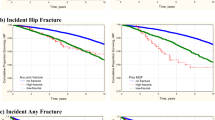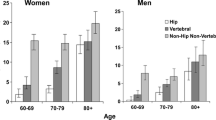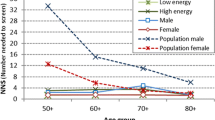Abstract
Summary
Few studies have examined the relationship between more-than-minimal-trauma fractures and bone density. This study demonstrated that more-than-minimal-trauma fractures are associated with lower bone density similar to that seen in minimal trauma fractures. Men and women over 50 years with a more-than-minimal-trauma fracture should be investigated to exclude low bone density.
Introduction
The aim of this study was to assess the prevalence and predictors of low bone density in men and women with more-than-minimal-trauma fractures.
Methods
In an Australian hospital, 630 community-dwelling men and women, 20 years of age or older, sustained a fracture due to more-than-minimal-trauma (force greater than a fall from standing height but less than high trauma). We studied 349 individuals who agreed to have a bone mineral density (BMD) scan. These participants were compared with 472 men and women with minimal trauma fractures.
Results
Men and women with more-than-minimal-trauma fractures had significantly lower bone density than expected for their age, gender and weight (Z-scorespine = −0.4 SD, 95 % confidence interval (CI), −0.5 to −0.3; Z-scorehip = −0.5 SD, 95 % CI, −0.6 to −0.4). Almost 1 in 4 of those over 50 years of age had osteoporosis by BMD criteria. The independent predictors of low bone density (T-score <−2.0 SD) were age equal to or over 50 years (odds ratio (OR) = 5.97, 95 % CI, 3.34 to 10.65), low body weight <20 kg/m2 (OR = 3.44, 95 % CI, 1.32 to 8.94), a prior minimal trauma fracture (OR = 2.76, 95 % CI, 1.17–6.52) and in those over 50 years of age, an osteoporosis-associated condition (OR = 4.51, 95 % CI, 1.69 to 12.06). Men and women with more-than-minimal-trauma fractures had similar bone density (Z-score) compared to those with minimal trauma fractures.
Conclusions
Men and women over 50 years with a more-than-minimal-trauma fracture, especially those with low body weight, prior minimal trauma fracture or an osteoporosis-associated condition, should be investigated to exclude low bone density and its associated risk of subsequent fractures.

Similar content being viewed by others
References
The burden of brittle bones: costing osteoporosis in Australia. Canberra: Access Economics, 2001. http://www.iofbonehealth.org/sites/default/files/PDFs/osteoporosis_australia_whitepaper_2001.pdf. Accessed 20 Feb 2015
Cooley H, Jones G (2009) A population based study of fracture incidence in southern Tasmania: lifetime fracture risk and evidence for geographic variations within the same country. Osteoporos Int 12:124–130
Sornat-Rendu E, Duboeuf F, Boutroy S, Chapurlat RD (2014) How to predict fragility fracture beyond 10 years? The OFELY study. J Clin Endocrinol Metab 99(12):4690–4697
Prior JC, Langsetmo L, Lentle BC et al (2015) Ten year incident osteoporosis-related fractures in the population-based Canadian multicentre osteoporosis study- comparing site and age-specific risks in women and men. Bone 71:237–243
Schuit SC et al (2004) Fracture incidence and association with bone mineral density in elderly men and women: the Rotterdam study. Bone 34(1):195–202
Miller PD et al (2002) Prediction of fracture risk in postmenopausal white women with peripheral bone densitometry: evidence from the national osteoporosis risk assessment. J Bone Miner Res 17(12):2222–2230
Cummings SR, Black DM, Nevitt MC et al (1993) Bone density at various sites for prediction of hip fractures. Lancet 341:72–75
Hui SL, Slemenda CW, Johnston CC (1988) Age and bone mass as predictors of fracture in a prospective study. J Clin Invest 81:1804–1809
Wasnich RD, Ross PD, Davis JW, Vogel JM (1989) A comparison of single and multi-site BMD measurements for assessment of spine fracture probability. J Nucl Med 30:1166–1171
Stone KL, Seeley DG, Lui L et al (2003) BMD at multiple sites and risk of fracture of multiple types: long-term results from the study of osteoporotic fractures. J Bone Miner Res 18:1947–1954
Haentjens P, Autier P, Collins J et al (2003) Colles fracture, spine fracture, and subsequent risk of hip fracture in men and women: a meta-analysis. J Bone Joint Surg 85(A):1936–1943
Klotzbuecher CM, Ross PD, Landsman PD, Abott TA, Berger M (2000) Patients with prior fractures have an increased risk of future fractures: a summary of the literature and statistical synthesis. J Bone Miner Res 15:721–739
Schroder HM, Peterson KK, Erlandsen M (1993) Occurrence and incidence of the second hip fracture. Clin Orthop 289:166–169
Van Staa TP, Leufkens HG, Cooper C (2002) Does a fracture at one site predict later fractures at other sites? A British cohort study. Osteoporosis Int 13(8):624–629
Kanis JA et al (2004) A meta-analysis of previous fracture and subsequent fracture risk. Bone 35(2):375–382
Center JR et al (2007) Risk of subsequent fracture after low-trauma fracture in men and women. JAMA 297(4):387–394
Bluic D, Nguyen ND, Milch VE, Nguyen TV, Eisman JA, Center JR (2009) Mortality risk associated with low-trauma osteoporotic fracture and subsequent fracture in men and women. JAMA 301(5):513–521
Center JR, Nguyen TV, Schneider P, Sambrook PN, Eisman JA (1999) Mortality after all major types of osteoporotic fractures in men and women: an observational study. Lancet 353(9156):878–882
Cauley JA, Thompson DE, Ensrud KC, Scott JC, Black D (2000) Risk of mortality following clinical fractures. Osteoporosis Int 11(7):556–561
Pongchaiyakul C, Nguyen ND, Jones G, Center JR, Eisman JA, Nguyen TV (2005) Asymptomatic vertebral deformity as a major risk factor for subsequent fractures and mortality: a long-term prospective study. J Bone Miner Res 20(8):1349–1355
Sanders KM, Pasco JA, Am U et al (1998) The exclusion of high trauma fractures may underestimate the prevalence of bone fragility fractures in the community: the geelong osteoporosis study. J Bone Miner Res 13:1337–1342
Mackey DC, Lui L, Cawthon PM et al (2007) High-trauma fractures and low bone density in older women and men. JAMA 298(20):2381–2388
Bone density testing in general practice. Osteoporosis Australia. http://www.osteoporosis.org.au/sites/default/files/files/Bone%20Density%20Testing%20in%20General%20Practice.pdf. Accessed 21 Feb 2015
Bone densitometry and medicare. The department of health. https://health.gov.au/internet/main/publishing.nsf/Content/diagnosticimaging-bd.htm. Accessed 21 Feb 2015
Clinician’s guide to the prevention and treatment of osteoporosis. National osteoporosis foundation 2014. https://my.nof.org/file/bonesource/Clinicians-Guide.pdf. Accessed 21 Feb 2015
Bliuc D, Alarkawi D, Nguyen TV, Eisman JA, Center JR. Risk of subsequent fractures and mortality in elderly women and men with fragility fractures with and without osteoporotic bone density. The Dubbo Osteoporosis Epidemiology Study. J B Miner Res. doi: 10.1002/jbmr.2393
Morin S, Tsang JF, Leslie WD (2009) Weight and body mass index predict bone mineral density and fractures in women aged 40 to 59 years. Osteoporos Int 20:363–370
Cuddihy MT, Gabriel SE, Crowson CS, O’Fallon WM, Melton L (1995) Forearm fractures as predictors of subsequent osteoporotic fractures. J Bone Joint Surg Am 77(3):387–395
Karlsson MK, Hasserius R, Obrant KJ (1993) Individuals who sustain nonosteoporotic fractures continue to also sustain fragility fractures. Calcif Tissue Int 53:229–231
Ojo F, Al Snih S, Ray LA et al (2007) History of fractures as predictor of subsequent hip and nonhip fractures among older Mexican Americans. JNMA 99(4):412–418
Warruber AH, Patkar NM, Yun H, Delzell E (2011) Minor, major, low-trauma and high-trauma fractures: what are the subsequent fracture risks and how do they vary? Curr Osteoporos Rep 9:122–128
Author information
Authors and Affiliations
Corresponding author
Ethics declarations
Conflicts of interest
None.
Electronic supplementary material
Below is the link to the electronic supplementary material.
Online resource 1
Histogram of the lowest T score in a) whole population b) < 50 years c) > 50 years . (PDF 22 kb)
Rights and permissions
About this article
Cite this article
Pereira, L., Bliuc, D., Stanford, P. et al. More-than-minimal-trauma fractures are associated with low bone density: an 8-year prospective study. Osteoporos Int 28, 103–110 (2017). https://doi.org/10.1007/s00198-016-3739-8
Received:
Accepted:
Published:
Issue Date:
DOI: https://doi.org/10.1007/s00198-016-3739-8




